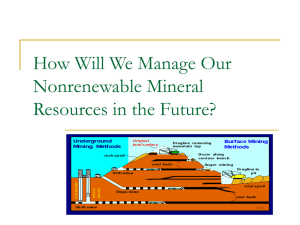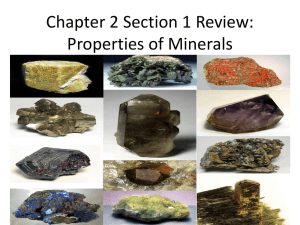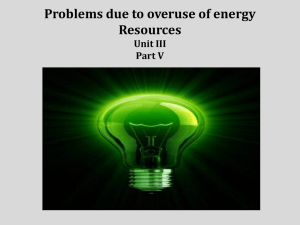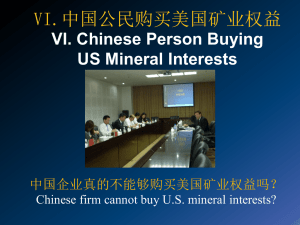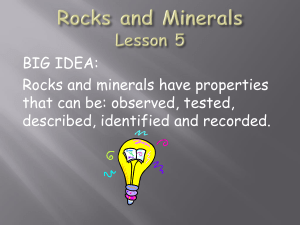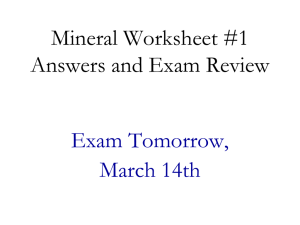Mineral – Subsurface
advertisement
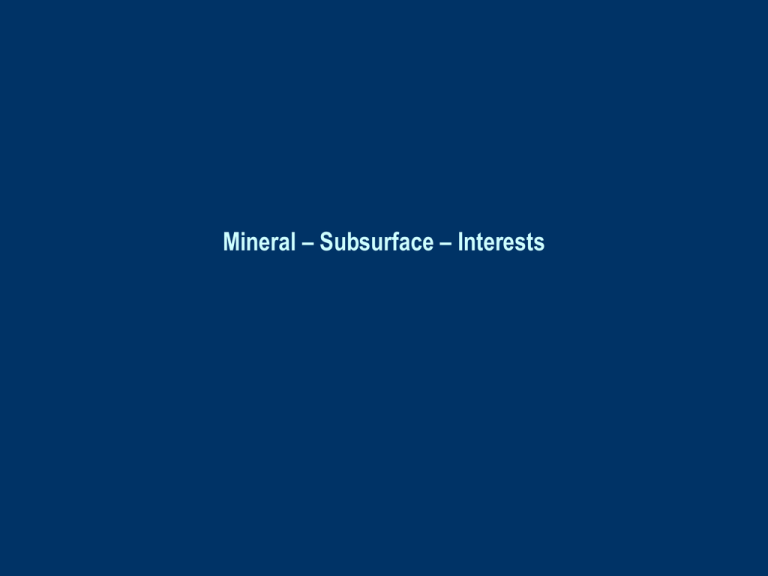
Mineral – Subsurface – Interests Cuius est solum, ejus est usque ad caelum et ad inferos Exercise of rights possessed may be limited – by the myriad jurisdictions in which we live State Legislature Statutory Law Legislative Mandate Agency Courts Case Law MINNESOTA LAW We muddle through ! Administrative Law Mining in Minnesota Taconite Operations Mines Plants Port facilities Industrial Minerals Crushed stone Limestone Peat Silica sand Kaolin clay Granite Continuing series: Frac Sand Fever (Star Tribune) FRACKING: Frac sand mining opponents call for statewide moratorium Frac Sand Mining (MPR) Sulfide Mining in Minnesota Minnesota's mining boom: New riches or new threat? (Star Tribune Sept. 11 2011) Before open pit copper mine opens in northern Minnesota, the expansion debate has started (Star Tribune Nov. 27, 2013) PolyMet: Developing the NorthMet Copper, Nickel Mining .. NorthMet Supplemental Draft Environmental Impact Statement Iron Mining in Minnesota History of the Iron Range (Iron Range Resources and Rehabilitation Board) Mining in Minnesota's Iron Range: Past and Future (Friends of the BWCA) History of Mining in Minnesota (www.miningartifacts.org) Minnesota Iron Mining (www.taconite.org) MPR: A timeline of Minnesota's Iron Range Iron Mining in Minnesota -1950's - YouTube Essar Steel Minnesota Minnesota Ore Operations - Keetac and Minntac Minn. State Policy Minnesota Statutes 93.001 Policy for mineral development (1987) “It is the policy of the state to provide for the diversification of the state's mineral economy through long-term support of mineral exploration, evaluation, environmental research, development, production, and commercialization” Ownership of subsurface interests – the rights to explore for any minerals, in general or specifically, and to mine • can be possessed by the entities possessing the rights to use the surface • may or may not be specified in the public record – deed – abstract • whether the owner can explore and mine depends on the jurisdiction in which the real estate is located Ownership of subsurface interests – the rights to explore for any minerals, in general or specifically, and to mine • can be possessed by the entities possessing the rights to use the surface • may or may not be specified in the public record – deed – abstract • whether the owner can explore and mine depends on the jurisdiction in which the real estate is located • • • can also be possessed by another entity – severed mineral interests – different minerals may or may not be specified in the public record – deed – abstract whether the owner of severed mineral interests can explore and mine depends on the jurisdiction in which the real estate is located Mineral Rights Title Search. How to Find Mineral Rights Ownership (You Tube) How to Verify Land Mineral Rights Ownership (eHow) I May Own Minerals, So Now What? (Mineral Rights Forum) Mineral Rights (Land Title Guarantee Co) State Imposed Encumbrances to Federal Title to Land donated for the Voyageurs National Park • Reservation of mineral and water power right – state owns mineral rights • Covenant not to exercise those rights Ownership of Land and Minerals in BWCAW The Izaak Walton League of America filed suit to determine the extent of the mineral rights possessed by George W. St. Clair and his successors in interest and whether he could exercise of those rights in the Boundary Waters Canoe Area (BWCA) • the Wilderness Act precludes any exercise of St. Clair's mineral rights in land within the boundaries of the BWCA • requested injunctions against the federal and state defendants to forbid them granting St. Clair any permits to explore for, drill for, or remove minerals from the BWCA This litigation, in the defendant St. Clair's words, was “born of frustration” Congress repeatedly memorialized to appropriate funds to purchase the private mineral rights – one of the recommendations of the Selke Committee on Review of the BWCA in 1963 to then Secretary of Agriculture Freeman – but has not done so This litigation, in the defendant St. Clair's words, was “born of frustration” Congress repeatedly memorialized to appropriate funds to purchase the private mineral rights – one of the recommendations of the Selke Committee on Review of the BWCA in 1963 to then Secretary of Agriculture Freeman – but has not done so Izaak Walton League of America v. St. Clair 353 F. Supp. 698 (D. Minn. 1973 • St. Clair is not at liberty to explore or prospect without a permit from the Forest Service Izaak Walton League of America v. St. Clair 497 F.2d 849 (8th Cir.), cert. denied, 419 U.S. 1009 (1974) • The case is reversed and remanded with directions that the Forest Service be allowed to determine, upon proper application, whether a permit should be granted Wilderness and the Judiciary (2009) http://waterlegacy.org/sites/default/files/SNFLandOwner_0.jpg Policy for Mineral Development Minnesota Statutes c.93 93.001 It is the policy of the state to provide for the diversification of the state’s mineral economy through long-term support of mineral exploration, evaluation, environmental research, development, production and commercialization Will there be taconite plant dominoes? Minnesota Iron Mining Tied to steel tracks (Federal Reserve Bank of Minneapolis) Minnesota pilot plant (Online Insider) Iron mining 2002 (MPR) Surprise revival for iron mines of Minnesota (Christian Science Monitor April 22,2004) Minnesota iron goes global (MPR May 19, 2005) In Minnesota, mining makes and comeback (CNN.com Nov 21, 2007) Session Daily - Mining proposals come under scrutiny (Jan. 25 2008) New mining era for northeastern Minnesota -- and new environmental worries (MinnPost.com Jan 24, 2008) Mining (Sierra Club, North Star Chapter) Financial Aspects of Iron Mining Minnesota Constitution Mineral Lands (Minnesota Statutes) Mining (Minnesota Statutes) Iron Ore Tax (Minnesota Statutes) Taconite and Iron Mining (Department of Revenue) Mining Tax Guide (Minnesota Department of Revenue) Mineral Taxes (Department of Revenue) Mining Tax Study (Minnesota Center for Fiscal Excellence) Minnesota iron mining-our communities, state and nation depend on it (Iron Mining Association of Minnesota) The Good and Bad News for Minnesota’s Iron Range Employment (Feb. 2011 Positively Minnesota) Iron Range Resources and Rehabilitation Board State of Minnesota economic development agency located in Eveleth, Minnesota Mission - to advance regional growth by stabilizing and enhancing the economy of northeastern Minnesota's Taconite Assistance Area Services include business development consulting and financial assistance •Business Financing •Low Interest Business Loans •Economic Development Grants •Minnesota Business Opportunities •Tax-Free Commercial Real Estate History of Agency Iron Range Resources Biennial Report Fiscal Years 2011-2012 Gender Discrimination North Country “It was like they'd never seen a woman before” (Guardian Feb 3, 2006) Lois E. Jenson et al v Eveleth Taconite Co. (FindLaw) Unofficial Jenson v Eveleth Taconite (Wikipedia) United States Treatment of Minerals Minerals & Mining Law (FindLaw) Intermountain Oil and Gas BMP Project (Natural Resources Law Center) Mountaintop Mining: Background on Current Controversies (CRS April, 2013) Mining Statutes (Bureau of Land Management) Land and Mineral Ownership (BLM) The Mining Act of 1872 (Wikipedia) Allowed individuals and corporations access to the public domain lands – lands that had always been owned by the federal government – to prospect for minerals and allow them to make a claim to the minerals they discovered This claim gave them the right to extract the minerals and title to both land and minerals could be "patented" by them The purpose of the legislation was to promote mineral exploration on the federal lands in the western United States Offered an opportunity for individuals to acquire title to mines that were already being worked The Mining Act of 1872 During the 19th century, silver and gold were mined under the provisions of the 1872 Act in Colorado, California, and Nevada In the 20th century deposits of copper were mined in Arizona and molybdenum and tungsten in Colorado One of the primary forces behind the development of copper, silver, gold, lead, molybdenum, and uranium The 1872 Act continues to provide the structure for much of the Western hardrock mining on public domain lands Hardrock Mining on Federal Lands (GAO) Hardrock Mining on Federal Lands (National Academies Press, 1999) Bureau of Land Management Bureau of Ocean Energy Management, Regulation and Enforcement Act February 18, 1873 c. 159 (17 Stat. 465) Excluded “deposits of coal and iron” in Minnesota and Michigan from the provisions of the Mining Act of 1872 Mineral Ownership The right to explore and mine may be owned by the surface owner Mineral Ownership The right to explore and mine may be owned by the surface owner Such rights may not be owned by the surface owner, in which case the mineral interests are severed • typically, mineral interests are retained when the surface is conveyed – in the deed of conveyance the seller reserves all or part of the mineral rights • less frequently, mineral interests are conveyed and the surface rights are retained Sometimes surface ownership records indicate whether ownership of the mineral interests are severed from the surface interests or not – often they do not Mineral Ownership The right to explore and mine may be owned by the surface owner Such rights may not be owned by the surface owner, in which case the mineral interests are severed • typically, mineral interests are retained when the surface is conveyed – in the deed of conveyance the seller reserves all or part of the mineral rights • less frequently, mineral interests are conveyed and the surface rights are retained Sometimes surface ownership records indicate whether ownership of the mineral interests are severed from the surface interests or not – often they do not Such severed mineral rights can be sold or donated by the owner In Minnesota, they may also be lost through tax forfeiture Mineral ownership in Minnesota Kotz, Mark “Who Owns Minnesota’s Buried Treasure?” (Sept –Oct 1990 The Minnesota Volunteer) How Can I Locate Who Owns the Mineral Rights Under My Land? (MineralHub) Your Land on Iron Range May Be Gold Mine — for Others (Duluth News Tribune April 2011) Minnesota Landowners Worried that Mining Companies Will Use Eminent Domain to Take Their Property (Oakdale Patch March 2012) Mineral rights basics (BusinessNorth.com) Minnesota’s Mining Laws • Laws on state-owned or administered lands and mineral rights • Laws on regulation of all exploration and mining activities • Laws on taxation of mineral interests • Other mineral related laws Department of Natural Resources Division of Land and Minerals Managing state’s mineral resources • Providing real estate services • Managing mineral exploration and mine development on all state owned land (surface, subsurface) to generate income (rents, royalty) for • Permanent School Fund • Permanent University Fund (PUF) • Local communities • General Fund • Ensuring mineral development is environmentally sound • Maintaining the real estate records Minerals Metallic Mineral Leasing • Marty Vadis, DNR Division of Land and Minerals (Jan – Feb 2009 Minnesota Conservation Volunteer) Metallic Mineral Exploration Drilling Preference rights lease for non-ferrous metallic mineral leasing Iron Mining - Taconite Minnesota Taconite Production Doubles in 2010 (Jan 3, 2011 CBS Minnesota) Taconite is back (March 27, 2011 Iseek.org) Hill-Rust- Mahoning Mine – a National Historic Landmark (Go Geometry) U. S. Steel Mine Expansion Project Taconite By-products Stockpile Ownership (June 2001 DNR ) Recycling Mining Materials as Durable Aggregates (Oct. 2010 MNDoT) The Establishment of a Permit to Mine Administration and Application Fee Schedule (Jan. 15 2009 DNR) MPR Story: Mainstreet Radio Special: Mining (Oct. 16, 2000) Iron Range Region (Minnesota Historical Society) Alanen Arnold R. “The “Locations” Company communities on Minnesota’s Iron Ranges” Mining Future Governor’s Committee on Minnesota’s Mining Future (Sept. 2004) Powerpoint presentations • • • Mining in Minnesota’s Iron Range: Past and Future Perspectives (Power, Thomas University of Montana) Power, Thomas “The Economic Role of Metal Mining in Minnesota: Past, Present, and Future” (Oct. 2007 Minnesota Center for Environmental Advocacy) Mining into the Future – Development in the Minnesota’s Mining Industry (June 9, 2009 Mining Minnesota) Non-ferrous Mining 1981 Report to the Legislature on Copper -Nickel Development (Feb. 8, 1981 State Planning Agency et al.) Midwest Mining Rush Threatens Water: Part VI: Minnesota: This Land is Your Land, This Land is My Land (Nov 22, 2010 Public Education Center) New law's effect: Minnesota streamlines pollution (March 11, 2011 Minnpost.com) Taconite and Asbestos The classic Reserve Mining case (Aspen Law School) Huffman, Thomas R. “Exploring the Legacy of Reserve Mining: What Does the Longest Environmental Trial in History Tell Us About the Meaning of American Environmentalism?” Journal of Policy History 12. 3 (2000) Huffman, Thomas R . “Asbestos and the Reserve Mining Trial” Minnesota History Fall 2005 The legacy of the Reserve Mining case (Oct 29, 2003 MPR) Minnesota Taconite Workers Health Study (University MN) Exposure to Commercial Asbestos in Northeastern Minnesota Iron Miners who Developed Mesothelioma (Nov. 25, 2003 MN Dept of Health) New cases of asbestos-related cancer to be included in University of Minnesota’s Taconite Workers Health Study (March 30, 2010) Health Risks of Taconite Mining Do taconite fibers cause cancer? (MPR March 28, 2003) Is Taconite Killing Miners? (MPR Aug 7, 2007) Rule and Implementation Information for Taconite Iron Ore Processing (EPA) Mesothelioma.net Minnesota Taconite Workers Health Study (University of Minnesota) Two Taconite Minnesota Mining Operations Could Be Held Accountable for Exceeding Asbestos Exposure Limits (Asbestos Network April 23, 2008) Other Environmental Issues Mercury and Mining in Minnesota (Oct. 15 2003) National Steel Pellet Company Draft Voluntary Mercury Reduction Agreement (Oct 28, 2011) Taconite Mining and Processing Industry Profile (Sept 2001 EPA) Mine Restoration Iron Ore And Taconite Mine Reclamation And Revegetation Practices On The Mesabi Range In Northeastern Minnesota The majority of mineral rights in Minnesota, either severed or not, are owned by private entities However, the state is the largest single owner of mineral rights The majority of mineral rights in Minnesota, either severed or not, are owned by private entities However, the state is the largest single owner of mineral rights – at least we think so How much it owns is uncertain because of the nature of the public record The majority of mineral rights in Minnesota, either severed or not, are owned by private entities However, the state is the largest single owner of mineral rights – at least we think so How much it owns is uncertain because of the nature of the public record • under land surface owned by the state donated by the federal government (state trust lands) – under surface still owned by state – under surface was sold after 1901 when state reserved minerals – severed The majority of mineral rights in Minnesota, either severed or not, are owned by private entities However, the state is the largest single owner of mineral rights – at least we think so How much it owns is uncertain because of the nature of the public record • under land surface owned by the state donated by the federal government (state trust lands) – under surface still owned by state – under surface was sold after 1901 when state reserved minerals – severed • under land surface that is tax forfeited – may be unsevered or severed The majority of mineral rights in Minnesota, either severed or not, are owned by private entities However, the state is the largest single owner of mineral rights – at least we think so How much it owns is uncertain because of the nature of the public record • under land surface owned by the state donated by the federal government (state trust lands) – under surface still owned by state – under surface was sold after 1901 when state reserved minerals – severed • under land surface that is tax forfeited – may be unsevered or severed • under privately owned land surface – severed – and potentially tax forfeitable The majority of mineral rights in Minnesota, either severed or not, are owned by private entities However, the state is the largest single owner of mineral rights – at least we think so How much it owns is uncertain because of the nature of the public record • under land surface owned by the state donated by the federal government (state trust lands) – under surface still owned by state – under surface was sold after 1901 when state reserved minerals – severed • under land surface that is tax forfeited – may be unsevered or severed • under privately owned land surface – severed – and potentially tax forfeitable Until recently and paradoxically, very little attention paid to the mineral estate Over the years the ownership of severed minerals has become obscure and fractionalized Some interests have been divided among so many descendants of the original owner that their fractional interests have become extremely small Over the years the ownership of severed minerals has become obscure and fractionalized Some interests have been divided among so many descendants of the original owner that their fractional interests have become extremely small The question of severed minerals has never been addressed by the Minnesota Supreme Court – the general rule in other parts of the country is that unless otherwise stated in the severance deed, the mineral estate carries with it the right to use so much of the surface as may be reasonably necessary to reach and remove the minerals Under this rule, the mineral owner has a right of entry or access to explore for and mine minerals beneath the surface of the land In Minnesota leases of state owned minerals require that a surface owner be compensated for any damages to the surface which arise from mining activities of the holder of the state mineral lease Means that the owner of a state mineral lease can disturb the land surface owner! Minnesota Statutes 93.01 Reservation of minerals and water powers (Laws 1889 c.22) • “The state hereby reserves for its own use all the iron, coal, copper, gold, and other valuable minerals, and all water powers in or upon all lands which now or hereafter may belong to it by virtue of any act of Congress” – lands donated to the state by the United States • “This reservation shall not apply to lands granted or contracted to be conveyed by the United States or by this state to aid in the construction of any railroad” Carlson v Minnesota Land and Colonization Company 113 Minn. 361; 129 N.W. 768 (1911); Buck v Walker 115 Minn. 239; 132 N.W. 205 (1911) Washburn v. Gregory 125 Minn. 491, 147 N.W. 706 (1914) the Minnesota Supreme Court determined that a severed mineral interest is a interest in land, separate from the surface and separately taxable – and separately tax forfeitable!! Minnesota Statutes 93.06 Reservation of minerals under navigable lakes (1909) • • • • all iron ores and other minerals on, in or under lands within this state which lie beneath the waters of navigable lakes and rivers belong to the state together with the right to enter upon such lands and explore for and mine and remove such iron ore and other minerals the state now has and since its organization has had the right to sell, lease, or otherwise use or dispose of such mineral lands and such iron ores and other minerals in the same manner as any other mineral lands, ores, or minerals belonging to the state the title of the state to such iron ore or other minerals, together with the right to explore for, mine, or remove the same, shall not be affected by the subsequent drying up of such lakes or rivers In Washburn v. Gregory 125 Minn. 491, 147 N.W. 706 (1914) the Minnesota Supreme Court determined that a severed mineral interest is a interest in land, separate from the surface and separately taxable Mineral thus do not forfeit if the overlying surface interest forfeits for nonpayment of taxes However, in practice, severed mineral interests have been valued and assessed for tax purposes only if the value of the minerals has been determined through drilling Deeds for Severed Minerals The absence of any taxation of mineral interests owned separately from the surface, except where drilling analysis is available, has encouraged the separation of ownership of surface and mineral estates and resulted in the creation of hundreds of thousands of acres of untaxed mineral estate lands which thus are immune from tax forfeiture Severed Mineral Interests Law • Because the ownership condition of many severed mineral interests was becoming more obscure and fractionalized over time, impairing mineral development in the state • It is in the public interest and serves a public purpose to identify and clarify these interests Minnesota Laws 1969 c 829 s 1; 1973 c 650 art 20 s 5; 1976 c 181 s 2; 1986 c 444; 2005 c 4 s 20 Did not apply to the following owners of mineral interests • • • the United States of America the State of Minnesota an American Indian tribe or band owning reservation lands in Minnesota Minnesota Statutes 272.039 Legislative findings and conclusions related to the taxation of minerals owned separately from the surface (Laws 1973 c.650 art. 20 s 1) “The legislature finds that a class of real property has been created which, although not exempt from taxation, is not assessed for tax purposes and does not, therefore, contribute anything toward the cost of supporting the governments which protect and preserve the continued existence of the property” Minnesota Statutes 272.039 Legislative findings and conclusions related to the taxation of minerals owned separately from the surface (Laws 1973 c.650 art. 20 s 1) “The legislature finds that a class of real property has been created which, although not exempt from taxation, is not assessed for tax purposes and does not, therefore, contribute anything toward the cost of supporting the governments which protect and preserve the continued existence of the property” The legislature further finds that the identification of separately owned mineral interests by taxing authorities requires title searches which are extremely burdensome and, where no public tract index is available, prohibitively expensive Minnesota Statutes 272.039 Legislative findings and conclusions related to the taxation of minerals owned separately from the surface (Laws 1973 c.650 art. 20 s 1) “The legislature finds that a class of real property has been created which, although not exempt from taxation, is not assessed for tax purposes and does not, therefore, contribute anything toward the cost of supporting the governments which protect and preserve the continued existence of the property” The legislature further finds that the identification of separately owned mineral interests by taxing authorities requires title searches which are extremely burdensome and, where no public tract index is available, prohibitively expensive This result is caused in part by the decision in Wichelman v. Messner 250 Minn. 88, 83 N.W. (2d) 800 (1957), where the so called "40 year law" was held inapplicable to mineral interests owned separately from surface interest The legislature finds that the province of Ontario in Canada, which has land ownership patterns and mineral characteristics similar to that of Minnesota, has imposed a tax of $.50 an acre on minerals owned separately from the surface since 1968, and $.10 an acre before that • for the purpose of requiring mineral interests owned separately from surface interests to contribute to the cost of government at a time when other interests in real property are heavily burdened with real property taxes, the legislature concludes that the taxation of severed mineral interests … is necessary and in the public interest, and provides fair taxation of a class of real property which has escaped taxation for many years – taxation • for the purpose of requiring mineral interests owned separately from surface interests to contribute to the cost of government at a time when other interests in real property are heavily burdened with real property taxes, the legislature concludes that the taxation of severed mineral interests … is necessary and in the public interest, and provides fair taxation of a class of real property which has escaped taxation for many years – taxation • to provide adequate identification of mineral interests owned separately from the surface and to prevent the continued escape from taxation of obscure and fractionalized severed mineral interests – public record From and after January 1, 1970, every owner of a severed mineral interest shall file for record in the county recorder office or in the registrar office in the county where the mineral interest is located a verified statement giving • • • • the owner's address interest in the minerals the legal description of the property upon or beneath which the interest exists, and the book and page number or the document number, in the records of the county recorder or registrar of titles, of the instrument by which the mineral interest is created or acquired The owner had to do the work!!! Minnesota Statutes 93.55 Forfeiture of severed mineral interest If the owner of a mineral interest fails to file the verified statement required • • before January 1, 1975 for interests owned on or before December 31, 1973 within of year after acquiring an interest not previously registered after December 31, 1973 The mineral interest shall forfeit to the state after notice and opportunity for hearing provided in this section – forfeiture process Minnesota Statutes 93.55 Forfeiture of severed mineral interest If the owner of a mineral interest fails to file the verified statement required • • before January 1, 1975 for interests owned on or before December 31, 1973 within of year after acquiring an interest not previously registered after December 31, 1973 The mineral interest shall forfeit to the state after notice and opportunity for hearing provided in this section – forfeiture process Before completing the hearing procedures the Commissioner of Natural Resources may lease the severed mineral interest Landowners fight state over lease of mineral rights (MPR, 2011) Minnesota Supreme Court Contos v Herbst 250 Minn. 88, 278 N.W.2d 732 (1979) (LexisNexis Academic) The owners of severed mineral contested the constitutionality of legislation requiring them to register their interests or forfeit them to the state The court affirmed the district court finding that severed and unsevered mineral interests were taxed in a uniform manner as required by Minn. Const. art. 10, § 1 and that there was sufficient evidence to support the reasonableness of the amount of the tax Because the severed mineral interests were generally older and fractionalized, the court agreed that the registration by publication requirement was not unreasonable and did not violate due process The court concluded, however, that the forfeiture procedures violated due process because the procedures did not provide the owners with notice or a hearing before the forfeiture of their mineral interests even if the owners could be easily located Alleged Status of Mineral Ownership State Ownership of Mineral Interests State owns both surface and mineral interests when the two real property classes have not been severed State Ownership of Mineral Interests State owns both surface and mineral interests when the two real property classes have not been severed • Surface acquired from the federal government under various federal statutes and never conveyed State Ownership of Mineral Interests State owns both surface and mineral interests when the two real property classes have not been severed • • Surface acquired from the federal government under various federal statutes and never conveyed Surface acquired under tax forfeiture statutes – but how do we know that the minerals – a separate taxable estate – became forfeit? State Ownership of Mineral Interests State owns both surface and mineral interests when the two real property classes have not been severed • • • Surface acquired from the federal government under various federal statutes and never conveyed Surface acquired under tax forfeiture statutes – but how do we know that the minerals – a separate taxable estate – became forfeit? Surface acquired under statutes authorizing land surface acquisition – but how do we know that the state acquired the mineral interest? State Ownership of Mineral Interests State owns both surface and mineral interests when the two real property classes have not been severed • • • • Surface acquired from the federal government under various federal statutes and never conveyed Surface acquired under tax forfeiture statutes – but how do we know that the minerals – a separate taxable estate – became forfeit? Surface acquired under statutes authorizing land surface acquisition – but how do we know that the state acquired the mineral interest? Special circumstances – lands submerged under public water State Ownership of Severed Mineral Interests State owns a mineral interest when it has been severed • State reserved the minerals when conveying title to the surface – after 1901 State Ownership of Severed Mineral Interests State owns a mineral interest when it has been severed • State reserved the minerals when conveying title to the surface – after 1901 • State only acquired title to the surface – Under the tax forfeiture statutes – Under statutes authorizing only – expressly? – land surface acquisition State Ownership of Severed Mineral Interests State owns a mineral interest when it has been severed • State reserved the minerals when conveying title to the surface – after 1901 • State only acquired title to the surface – Under the tax forfeiture statutes – Under statutes authorizing only – expressly? – land surface acquisition • State may own a severed mineral interest when the mineral interest owners have failed to record their interests, therefore the mineral interests are tax forfeitable Minerals Interests on Trust Lands – fairly certain Mineral Interests on Tax Forfeited Lands – fairly uncertain Mineral Interests on Consolidated Conservation Lands – fairly uncertain Fairly certain State-owned Severed Fractional Mineral Interests – fairly certain Cave Ownership Helpful Hints for the Cave Landowner The Legal Aspects of Cave Ownership. Twenty-two states and Puerto Rico, and the Cherokee Nation currently have laws that cover a variety of topics ranging from definitions, protections of features, permits for excavation and scientific investigation, vandalism, and liability Most state cave laws state that it is illegal to remove or damage anything from a cave, including rocks, formations, animals, or organisms Cave & Karst Resources (National Park Service) National Speleological Society

